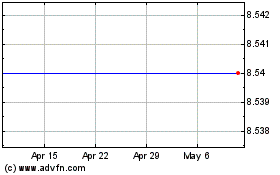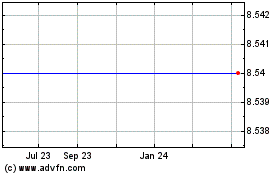Catabasis Pharmaceuticals Announces Phase 3 PolarisDMD Trial Enrolled Expected Patient Population
December 16 2019 - 8:00AM
Business Wire
-- Analysis Shows Patients Enrolled in Phase 2
MoveDMD and Phase 3 PolarisDMD Trials of Edasalonexent in Duchenne
Muscular Dystrophy Have Similar Baseline Characteristics --
Catabasis Pharmaceuticals, Inc. (NASDAQ:CATB), a clinical-stage
biopharmaceutical company, today announced the results from an
analysis of the baseline characteristics of the Phase 3 PolarisDMD
trial of edasalonexent in Duchenne muscular dystrophy (DMD). The
analysis shows that overall the patients enrolled in the Phase 3
trial have similar characteristics to the patients that enrolled in
the previous Phase 2 MoveDMD trial. Top-line results from the Phase
3 PolarisDMD trial are expected in the fourth quarter of 2020 and
the trial is anticipated to support an NDA filing in 2021.
Both the Phase 3 PolarisDMD trial and the Phase 2 MoveDMD trial
enrolled boys affected by DMD ages 4 to 7 (up to 8th birthday) with
any mutation type whom had not been on steroids for the previous 6
months. The Phase 3 trial enrolled 131 boys at 37 sites in the
United States, Canada, Europe, Israel and Australia and 98% were
steroid-naïve. The Phase 2 trial enrolled 31 boys in the United
States, all of whom were steroid-naïve. A comparison was made
between the populations at the baseline of each trial. Baseline
age, North Star Ambulatory Assessment (NSAA) score and timed
function test values (time to stand, 4-stair climb, and 10-meter
walk/run) were similar in both trials; there were no significant
differences in these baseline characteristics between the two
trials. Distribution of baseline NSAA and timed function tests was
less variable in the Phase 3 trial than in the Phase 2 trial. These
findings support the assumptions on which the Phase 3 trial was
powered. Boys in the Phase 3 trial had an elevated heart rate and
elevated muscle enzyme levels at baseline, which was also
consistent with the Phase 2 trial population.
Mean ± sd
PolarisDMD (n=131)
MoveDMD(n=23) Age (years) 5.7 ± 1.0 6.0 ± 1.1 Percent
enrolled patients that had not taken steroids
98%
100%
NSAA score 20.8 ± 4.7 20.1 ± 5.5 10-meter walk/run speed (1/s)
0.181 ± 0.037 0.168 ± 0.045 4-stair climb speed (1/s) 0.265 ± 0.097
0.254 ± 0.110 Time to stand speed (1/s) 0.212 ± 0.070 0.193 ± 0.080
“We are pleased to see that as expected, the patient population
enrolled in our Phase 3 PolarisDMD trial is consistent with the
patient population enrolled in the Phase 2 MoveDMD trial, which
supports our design for the Phase 3 trial. The overwhelming
positive interest from physicians and families and the rapid
enrollment of the trial reinforces the strong demand for a
well-tolerated treatment like edasalonexent with the potential to
slow disease progression and preserve muscle function,” said Joanne
Donovan, M.D., Ph.D., Chief Medical Officer of Catabasis. “We look
forward to sharing results from the trial next year and are
dedicated to bringing hope and life changing therapies to patients
and their families.”
“The baseline age and functional abilities of the boys enrolled
in the Phase 3 trial confirm that we have enrolled the expected
patient population and also that this patient population is similar
to published natural history studies of boys in this age range who
are not on steroids,” said Richard Finkel, M.D., Chief, Division of
Neurology, Department of Pediatrics at Nemours Children’s Health
System and a Principal Investigator for the Phase 2 and Phase 3
trials with edasalonexent. “There is a clear need for a therapy
that could benefit all patients affected by Duchenne, regardless of
mutation type, by slowing disease progression while being well
tolerated. I am pleased to be participating in this important Phase
3 trial of edasalonexent.”
In the earlier MoveDMD trial and open-label extension,
edasalonexent preserved muscle function and substantially slowed
disease progression compared to rates of change in the
off-treatment control period, significantly improved biomarkers of
muscle health and inflammation and was well-tolerated. In more than
60 cumulative patient years of exposure, the majority of adverse
events were mild in nature, and the most common treatment-related
adverse event was diarrhea, generally mild and transient. There
were no serious adverse events observed on treatment, and no
adverse trends in chemistry, hematology, or measures of adrenal
function.
About Edasalonexent (CAT-1004)
Edasalonexent (CAT-1004) is an investigational oral small
molecule designed to inhibit NF-kB that is being developed as a
potential foundational therapy for all patients affected by DMD,
regardless of their underlying mutation. In DMD the loss of
dystrophin leads to chronic activation of NF-kB, which is a key
driver of skeletal and cardiac muscle disease progression. Our
ongoing global Phase 3 PolarisDMD trial is evaluating the efficacy
and safety of edasalonexent for registration purposes.
Edasalonexent is also being dosed in the open-label extension trial
GalaxyDMD. In our MoveDMD Phase 2 trial and open-label extension,
we observed that edasalonexent preserved muscle function and
substantially slowed disease progression compared to rates of
change in a control period, and significantly improved biomarkers
of muscle health and inflammation. The FDA has granted orphan drug,
fast track, and rare pediatric disease designations and the
European Commission has granted orphan medicinal product
designation to edasalonexent for the treatment of DMD. For a
summary of clinical results, please visit www.catabasis.com.
About Phase 3 PolarisDMD Trial
The global Phase 3 PolarisDMD trial is a one-year, randomized,
double-blind, placebo-controlled trial evaluating the efficacy and
safety of edasalonexent in patients with DMD. The trial enrolled
patients ages 4 to 7 (up to 8th birthday) regardless of mutation
type who had not been on steroids for at least 6 months. Boys on a
stable dose of eteplirsen were also eligible to enroll. The primary
efficacy endpoint is change in the North Star Ambulatory Assessment
score after 12 months of treatment with edasalonexent compared to
placebo. Key secondary endpoints include the age-appropriate timed
function tests: time to stand, 4-stair climb and 10-meter walk/run.
Assessments of growth, cardiac and bone health are also included as
important potential areas of differentiation. For each boy that
receives placebo, two boys are receiving 100 mg/kg/day of
edasalonexent and after 12 months, all boys are expected to receive
edasalonexent in the open-label extension study GalaxyDMD. The
PolarisDMD trial design was informed by discussions with regulators
as well as input from treating physicians, patient organizations
and families of boys affected by Duchenne. Top-line results from
the Phase 3 PolarisDMD trial are expected in the fourth quarter of
2020. More information about the Phase 3 PolarisDMD clinical trial
is available on clinicaltrials.gov.
About Catabasis
At Catabasis Pharmaceuticals, our mission is to bring hope and
life-changing therapies to patients and their families. Our lead
program is edasalonexent, an NF-kB inhibitor in Phase 3 development
for the treatment of Duchenne muscular dystrophy. For more
information on edasalonexent and our Phase 3 PolarisDMD trial,
please visit www.catabasis.com.
Forward Looking Statements
Any statements in this press release about future expectations,
plans and prospects for the Company, including statements about
future clinical trial plans including, among other things,
statements about the Company’s global Phase 3 PolarisDMD trial in
DMD to evaluate the efficacy and safety of edasalonexent for
registration purposes and the open-label extension trial GalaxyDMD,
including the anticipated timing for top-line results, the
potential timing for the filing of an NDA, the Company's cash
expectations, the Company’s planned transition to a
commercial-stage organization and other statements containing the
words “believes,” “anticipates,” “plans,” “expects,” “may” and
similar expressions, constitute forward-looking statements within
the meaning of the Private Securities Litigation Reform Act of
1995. Actual results may differ materially from those indicated by
such forward-looking statements as a result of various important
factors, including: uncertainties inherent in the initiation and
completion of preclinical studies and clinical trials and clinical
development of the Company’s product candidates; whether interim
results from a clinical trial will be predictive of the final
results of the trial or the results of future trials; expectations
for regulatory approvals to conduct trials or to market products;
availability of funding sufficient for the Company’s foreseeable
and unforeseeable operating expenses and capital expenditure
requirements; other matters that could affect the availability or
commercial potential of the Company’s product candidates; and
general economic and market conditions and other factors discussed
in the “Risk Factors” section of the Company’s Annual Report on
Form 10-Q for the year ended September 30, 2019, which is on file
with the Securities and Exchange Commission, and in other filings
that the Company may make with the Securities and Exchange
Commission in the future. In addition, the forward-looking
statements included in this press release represent the Company’s
views as of the date of this press release. The Company anticipates
that subsequent events and developments will cause the Company’s
views to change. However, while the Company may elect to update
these forward-looking statements at some point in the future, the
Company specifically disclaims any obligation to do so. These
forward-looking statements should not be relied upon as
representing the Company’s views as of any date subsequent to the
date of this release.
View source
version on businesswire.com: https://www.businesswire.com/news/home/20191216005135/en/
Investor and Media Andrea Matthews
Catabasis Pharmaceuticals, Inc. T: (617) 349-1971
amatthews@catabasis.com
Catabasis Pharmaceuticals (NASDAQ:CATB)
Historical Stock Chart
From Mar 2024 to Apr 2024

Catabasis Pharmaceuticals (NASDAQ:CATB)
Historical Stock Chart
From Apr 2023 to Apr 2024
